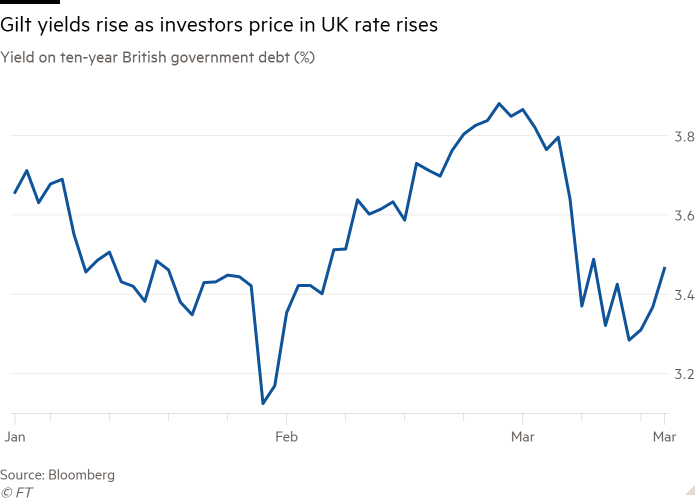US government bond prices rallied on Wednesday after the Federal Reserve signalled it was close to the end of its cycle of interest rate increases.
The US central bank on Wednesday lifted its benchmark interest rate by 0.25 percentage points to a target range of 4.75 per cent to 5 per cent, despite recent problems in the banking sector.
However, in its statement accompanying the decision, the Fed’s monetary policy committee removed previous references to the need for “ongoing” rate rises.
“It feels like if this is not the last hike, then it is certainly close,” said George Goncalves, head of US macro strategy at MUFG. “The rates market has certainly taken that as the message.”
The yield on the two-year Treasury note, which is the most sensitive to short-term policy expectations, dropped 0.24 percentage points to 3.93 per cent, while the benchmark 10-year yield fell 0.17 percentage points to 3.43 per cent. Lower yields reflect higher prices.
The collapse of Silicon Valley Bank and UBS’s takeover of Credit Suisse earlier this month had already led many investors to scale back their expectations for how long the Fed will keep rates at elevated levels.
Fed chair Jay Powell told reporters on Wednesday that SVB’s collapse would have a comparable impact to an extra interest rate hike. He added, however, that “if we need to raise rates higher, we will”.
The central bank also published revised projections about the path for monetary policy to 2025, along with updated forecasts for growth, unemployment and inflation.
Most officials maintained their forecast for interest rates to peak at between 5 per cent and 5.25 per cent and continued to predict that rates would remain at that level for an extended period before cuts begin next year.
However, interest rate futures markets suggested most investors expect the central bank to begin cutting much sooner.
Ashish Shah, chief investment officer of public investing at Goldman Sachs Asset Management, downplayed the reliability of the Fed’s forecasts, predicting the central bank would be “informed by what happens in both the economy and banking sector” because of the “considerable uncertainty”.
Stock markets struggled for direction in the aftermath of the Fed’s decision, with the S&P 500 index swinging between gains and losses before eventually closing 1.7 per cent lower. The tech-heavy Nasdaq Composite fell 1.6 per cent.
Shares in US banks gave up gains after Treasury secretary Janet Yellen said on Wednesday that the Biden administration was not considering a broad expansion of bank deposit insurance or “blanket” guarantees for savers.
The KBW Nasdaq Bank index fell 4.7 per cent. Shares in First Republic, the hardest hit among regional banks that have been suffering massive outflows of deposits, fell 15 per cent.
European equities closed higher. The region-wide Stoxx 600 rose 0.2 per cent and the CAC 40 in Paris finished 0.3 per cent higher.

London’s FTSE 100 rose 0.4 per cent after UK inflation unexpectedly jumped to 10.4 per cent in February, bolstering market expectations that the Bank of England would increase its benchmark interest rate on Thursday. Investors now expect a quarter-point rate rise from the BoE.
Neil Birrell, chief investment officer for Premier Miton, said the BoE faced a similar challenge to the Fed. “The equation is raising rates to beat inflation, but not squash the economy and make sure the financial system remains robust — that makes everything more difficult.”
Sterling rose 0.5 per cent against the dollar, approaching a two-month high, while the yield on the 10-year gilt rose 0.09 percentage points to 3.45 per cent. The yield on two-year gilts rose 0.2 percentage points to 3.48 per cent.
European Central Bank president Christine Lagarde on Wednesday warned of a “tit-for-tat” dynamic between workers and companies that shifts up profit margins and wages, increasing price pressures as both groups try to avoid a hit from higher inflation. Her comments helped push the euro up 0.9 per cent to $1.086, its strongest level since early February.
Asian stocks advanced, with Hong Kong’s Hang Seng index adding 1.7 per cent and South Korea’s Kospi rising 1.2 per cent. Japan’s Topix jumped 1.7 per cent after markets reopened following a one-day break for the vernal equinox holiday.

